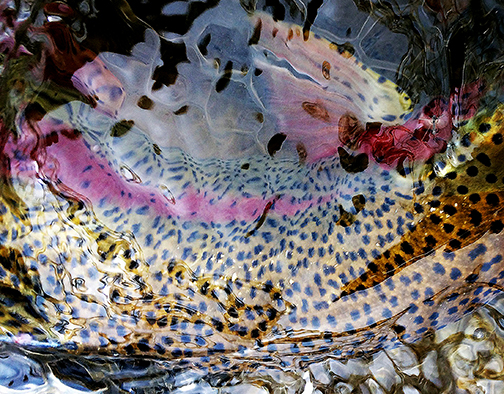Don’t tread on the redd! It’s spawning time

The vibrant spring colors of a rainbow trout.
Warming spring days lure anglers to local rivers hoping to hook up with willing trout. The trout, meanwhile, are busy seeking their own sort of hookup. It is a well-documented conflict: winter-weary fly fishers get passionate about their favorite pursuit just as the trout get passionate about each other.
Sentiment on the ethics of fishing during spawning season abounds. The compromise position holds that it is acceptable to fish during the spawn, but not to fish to spawning trout. It is an important distinction, and one that can affect the next generation of trout.
Spring is spawning season for rainbow trout, while brown trout spawn in the fall. Locally, rainbows are moving into spawning areas now, according to Kendall Bakich, aquatic biologist with the Glenwood Springs office of Colorado Parks and Wildlife.
“It’s the time of year that rainbows are creating the next age class of fish,” she said.
Females create redds, or spawning beds, where they lay eggs. Water temperature and flows dictate when actual spawning occurs, Bakich said. In years of big snowpack, the activity occurs in May and early June. Lower runoff means rainbows are spawning in April and May.
Well-informed anglers know what to look for, and what to avoid. Redds are created in gravelly and often shallow areas of moving water. Females turn over and clean marble-sized rocks with their tails. Redds appear as brighter, lighter swaths of gravel than the river bottom surrounding them.
Pairs of trout may be observed close together over a redd when they are spawning. The female will lay eggs there and the male will fertilize them. Fertilized eggs settle into the groomed gravel until they hatch. Unless they are dislodged or smashed underfoot.
“One thing you don’t want to do if you see bright gravel is trample over it,” Bakich advised. “You might be destroying eggs.”
Dog owners, too, should be cognizant of spawning seasons. Look for signs of redds and spawning trout before letting four-legged friends plow into the water.
Fishing to spawning trout – often very large fish holding in very shallow water – is tempting. Resist. Trout expend energy building and protecting a redd, and mating. Hooking one is disruptive to reproduction and saps the fish of needed energy. Moreover, handling a female that is ready to lay eggs may result in her dropping the eggs on the riverbank. Such stressors may similarly result in a male releasing its milt.
Rainbows caught during the spawn are best released quickly, without taking them out of the water. Don’t squeeze them, Bakich stressed.
Spawning closures
Angling for fish in deep pools and areas away from redds, and fishing for opportunistic brown trout lurking downstream of spawning rainbows (an egg pattern is a good bet) will help protect the rainbows of tomorrow. Further protections are mandated in some local sections of the Colorado and lower Roaring Fork rivers. Tributaries in these areas are a draw for spawning trout and whitefish. CPW has implemented spring and fall closures to protect spawning fish in the following stretches:
Colorado River – No fishing within 50 yards up- or downstream of its confluences with Canyon, Elk, Grizzly and No Name creeks from March 15-May 31 and Oct. 1-Nov. 30. Similarly, the creeks are closed to fishing for a half-mile upstream from their confluence with the Colorado River during the same periods (for Canyon Creek, the closure is from the I-70 bridge downstream to the confluence with the Colorado).
Roaring Fork River – No fishing within 50 yards up- or downstream of its confluences with Fourmile Creek and Threemile Creek from March 15-May 31 and Oct. 1-Nov. 3. Similarly, the creeks are closed to fishing for a half-mile upstream from the confluence with the Roaring Fork during the same periods.
Time to renew your fishing license
The 2024-25 fishing license expires March 31. A new license is required starting April 1, 2025. The 2025-26 license is valid through March 31, 2026. Open Space and Trails rangers will check anglers for licenses while patrolling sections of the Roaring Fork River under OST management.
2025 Colorado Fishing brochure
– By Pitkin County Open Space and Trails
